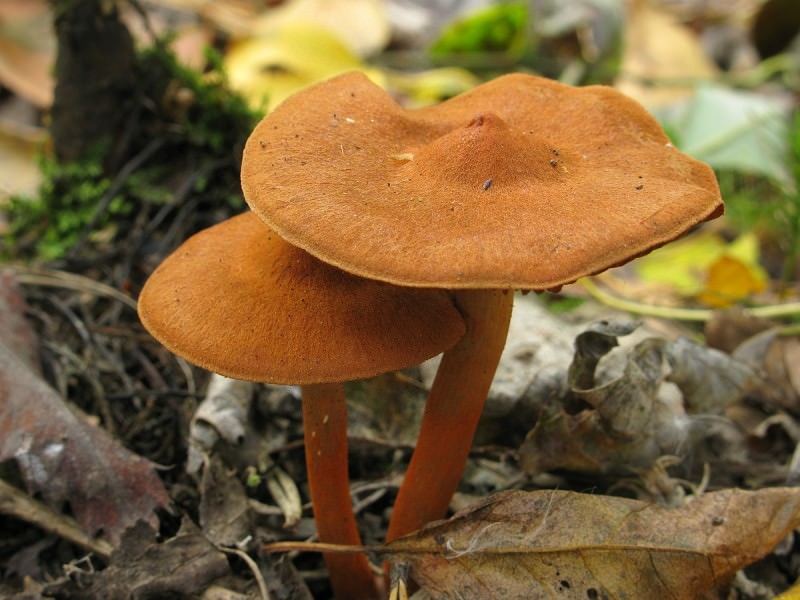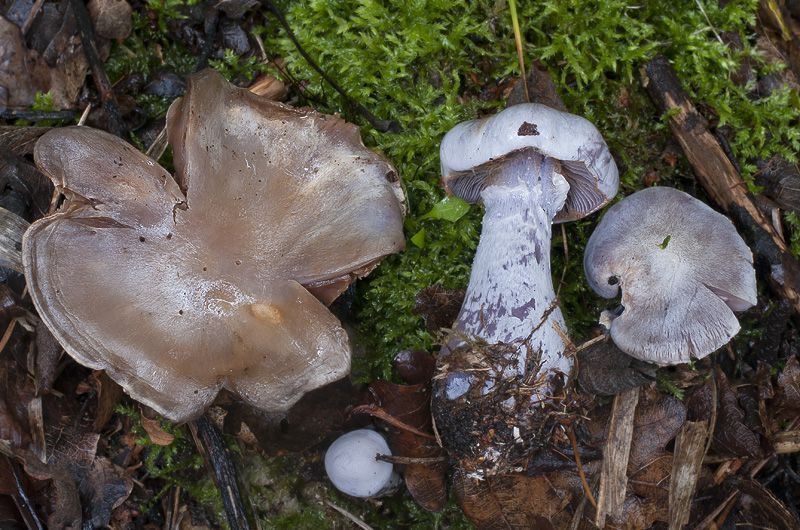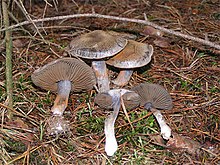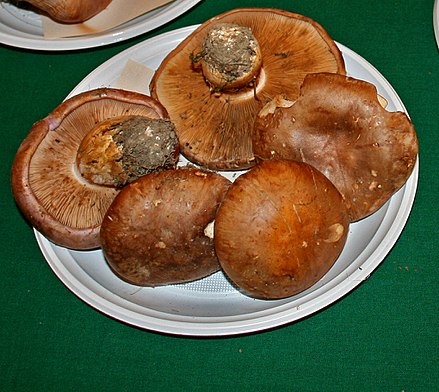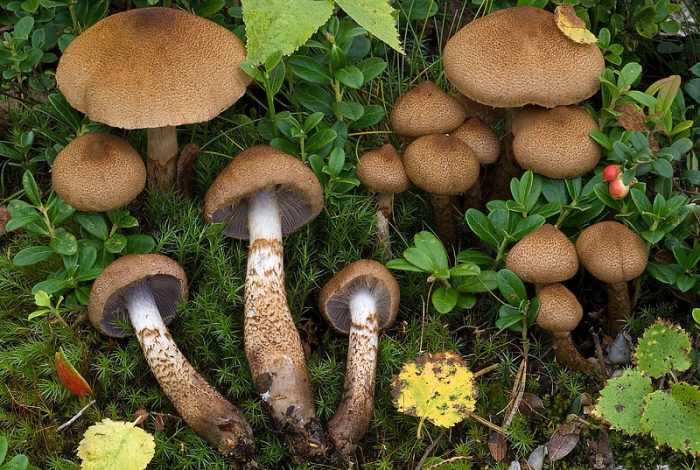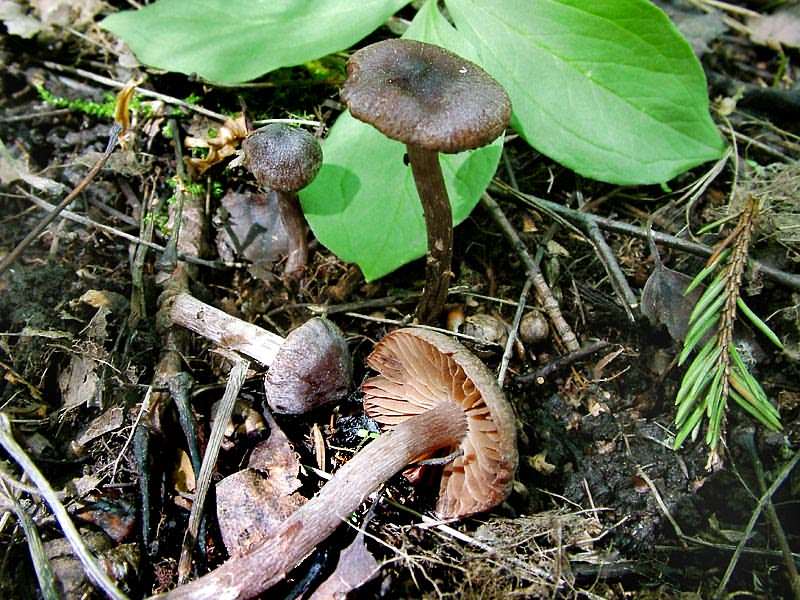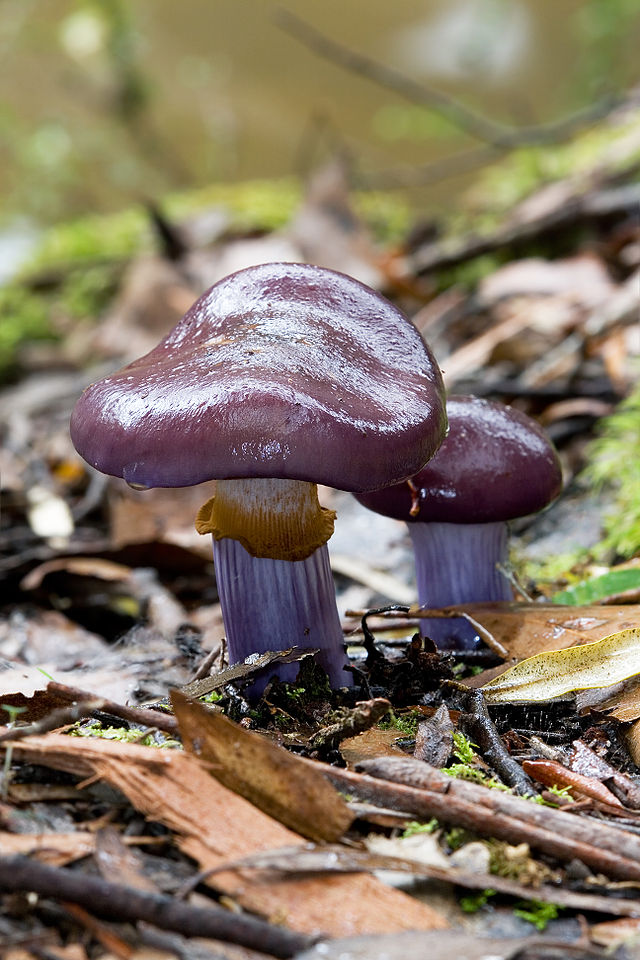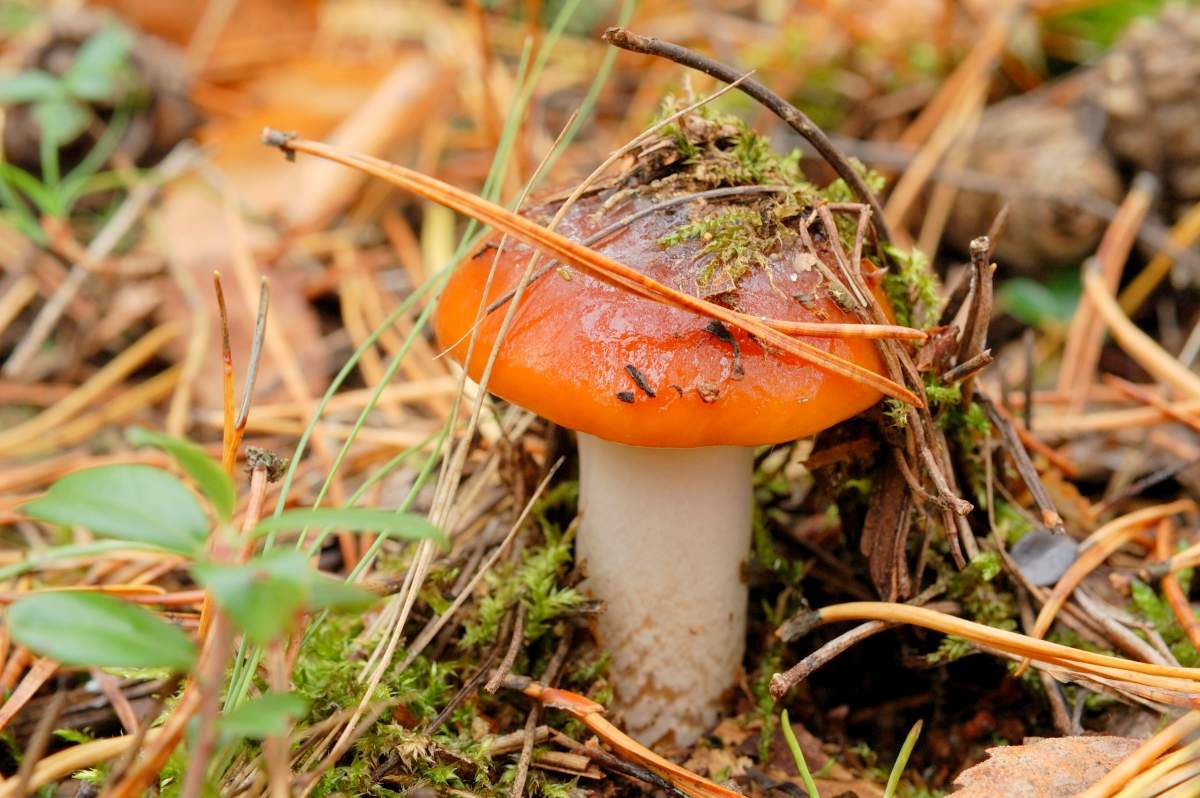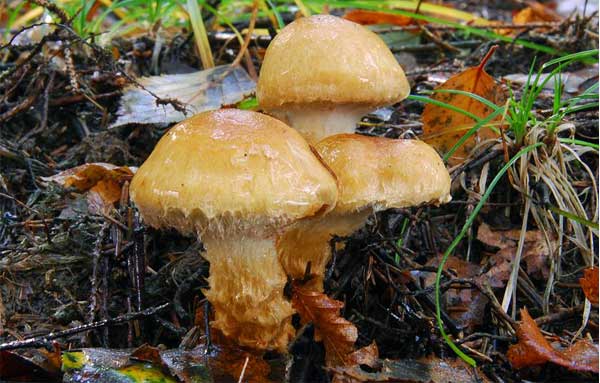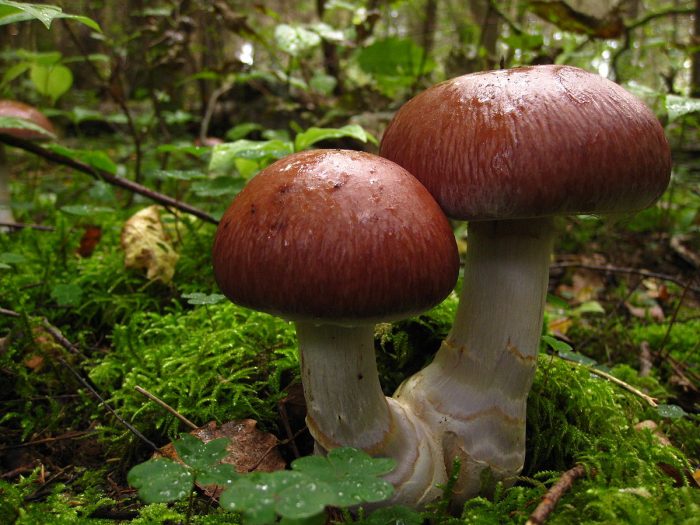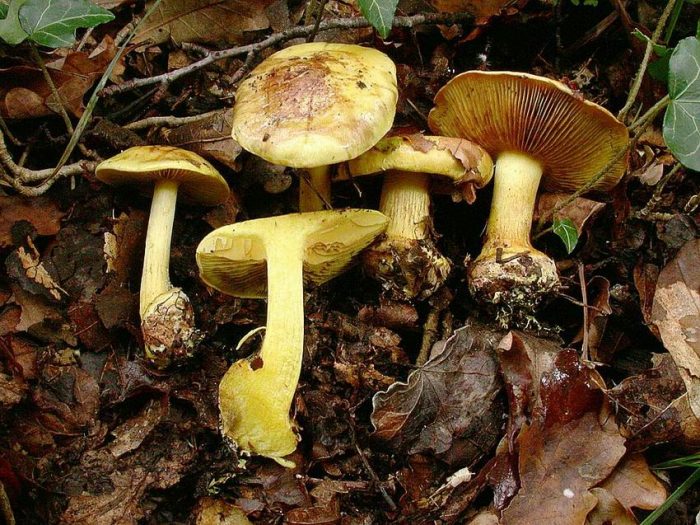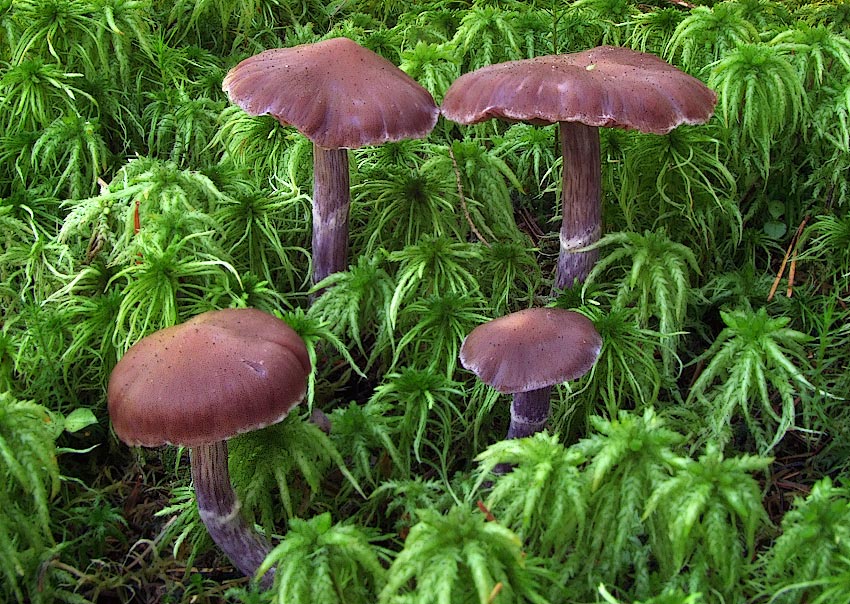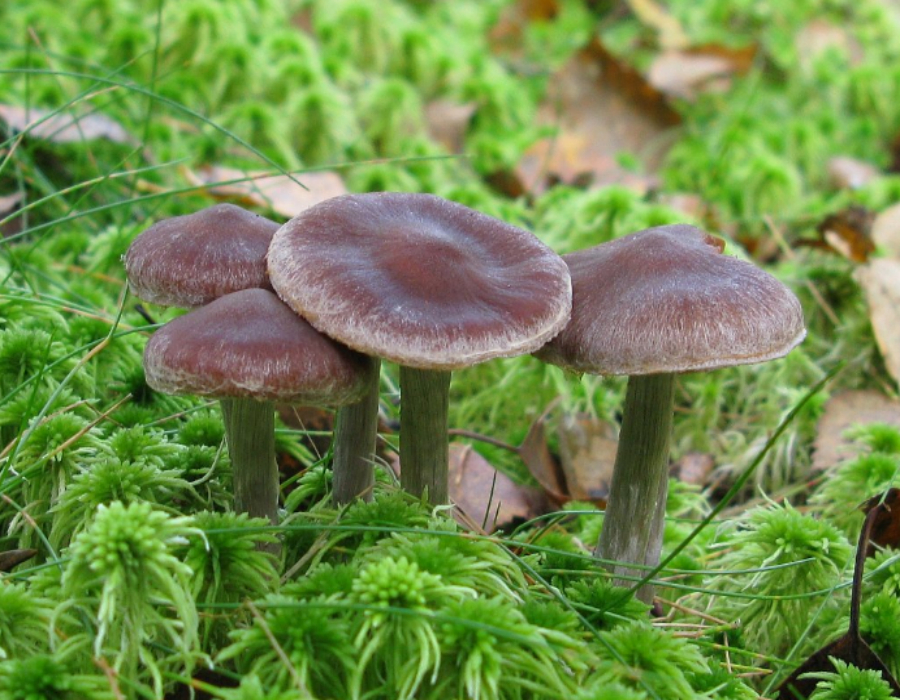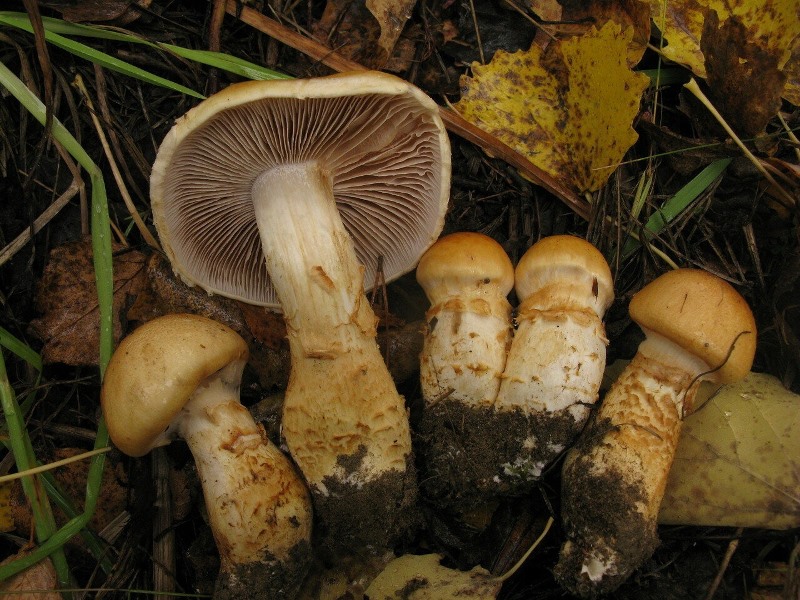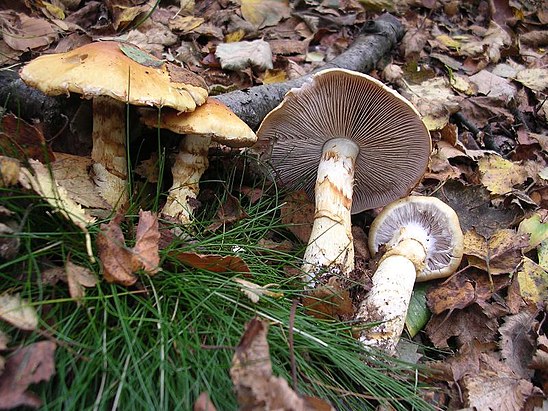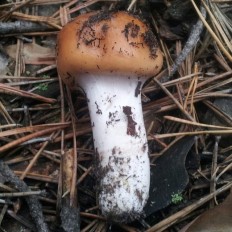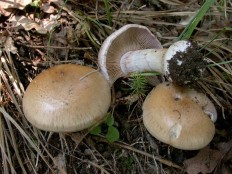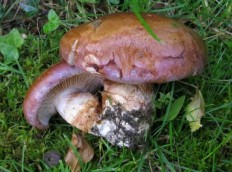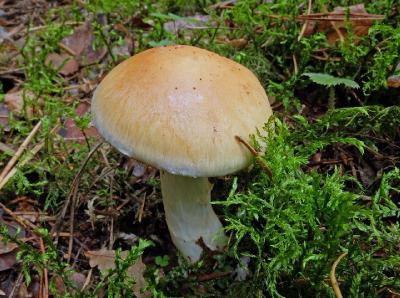Light ocher webcap - Cortinarius claricolor
Written by Nikolay Budnik and Elena Meck.
Light ocher webcap comes across quite rarely. At first we thought it was an apricot Webcap. But time passed, and kind people suggested that this was not the Apricot Webcap at all, but Cortinarius claricolor.
Light ocher webcap grows in dry pine forests, among green and white moss. Usually only the hat sticks out in the moss. From a distance, a young light ocher Webcap can be confused with a porcini mushroom - your heart stops, you run to pick this mushroom as soon as possible, but when you come closer and twist a thick leg out of the moss, instead of tubes you see a white cobweb blanket and plates.
We have long met the Light ocher Webcap in the forests, and in 2010 we got the courage to try it: we cut it, boiled it just in case, and fried it. I liked the light ocher webcap very much - hard, light, tasty.
There is practically no information in the domestic literature, and foreign sources call this mushroom inedible or even slightly poisonous! Therefore, we will not recommend for collection. Themselves ate, thank God, without consequences.
1. Light ocher webcap - strong and weighty mushroom.
2. We always met him in September.
3. When you see a young light ocher spider web, sometimes you confuse it with a porcini mushroom.
4. Older copies are more difficult to confuse.
5. Light ocher cobweb grows in a dry pine forest.
6. Sometimes mushrooms are found in large families.
7. Light ocher webcap prefers rather open areas.
eight. . green and white moss.
nine. . often with lingonberry.
10. The cap of the spider web is of a light ocher noble brownish color.
11. Initially, the edges of the cap are bent down.
12. Gradually they open up and the cap becomes almost flat.
13. The plates are at first tightly covered with a light cobweb blanket.
14. You can take a closer look.
15. Then the veil disappears, and a light trace remains from it along the edge of the cap.
16. Here you can see the records up close.
17. Plates darken with time.
18. They acquire a clay color (like all cobwebs).
19. The leg of the light ocher spider web is rather long and fleshy.
20. It is light in color, usually straight and even, sometimes slightly widened downward.
21. The remains of the bedspread are often visible on the leg.
22. On a cut, the leg is solid, juicy and strong.
23. So it connects with the cap in young mushrooms.
24. The flesh of the mushroom is white, sometimes a little bluish-purple.
25. She is strong, tender and juicy. In addition, the fungus is almost not affected by insect larvae.
26. In general, I really want to eat this mushroom, which we did once.
27. The next eight photos were taken on September 13, 2012. Their history is as follows.
28. Once we were returning home with full baskets. It was already evening, twilight.
29. And then we came across a witch circle of some mushrooms. There were 45-50 of them!
30. At first it seemed that these are triumphal cobwebs.
31. But upon closer inspection, it turned out that it was not them.
32. The color of the mushrooms was a little different, the texture itself was a bit different, and, most importantly, there were no three characteristic belts on the legs.
33. We decided to take a few mushrooms and examine them more closely in the light.
34. At home, we realized that it was a witch's circle of light ocher cobwebs. Such a miracle was shown to us by the goblin grandfather!
And now a small video filmed in the forests of Uloma Zheleznaya.
Description
This genus has earned the name "spiderwebs" because of the cobweb-like remains of velum under the cap in the form of threadlike fragments. And the species in question is named plush because of the velvet, even slightly rough, surface of the cap and leg to the touch.
Hat
Plush cobweb caps are small, neat, up to 8 cm in diameter.Form - from hemispherical (at a young age) to flat (at a mature state). Color - golden (shades - from orange to reddish brown). The surface is rough due to multiple flakes, remains dry in all weather conditions.
Leg
The leg of the plush spider web has medium dimensions: up to 9 cm long and up to 2 cm thick. It has the shape of a cylinder with a narrowing downward. The surface is fibrous and rough. The color is usually pale yellow.
Spore-bearing layer
The spore layer consists of plates adhering to the pedicle. At first, the plates are dark carrot, over time they darken and acquire a rust color. They are located quite rarely.
Pulp
Like most members of the genus, the plush webcap has a dense, pale yellow flesh. It emits a mild radish smell.
Help in case of poisoning with a shiny cobweb.
As noted, the toxin has a long-term effect, therefore, signs of poisoning appear only after 36 hours or several days. Therefore, treatment with the aim of removing toxins from the body has certain characteristics.
If the diagnosis was made before 6 days after the poisoning, detoxification methods are used to remove the poison. Next, doctors stop abdominal pain and vomiting. For the treatment of acute renal failure, prednisol is administered. The situation can be so critical that a kidney transplant may be needed. The picture of poisoning with shiny cobwebs differs from poisoning with other mushrooms precisely by a long latency period and impaired kidney function.
Related species of the glittering spider web.
The cobweb is an edible relative of the brilliant cobweb. His hat is convex, gray-violet in color. The pulp without a characteristic smell and taste, lilac color. The leg is cylindrical, filled inside, white, and brown downward.
Large cobwebs settle on sandy soils of deciduous and coniferous forests. On the territory of many European countries, this type of webcap is widespread. They are collected in September.
Bracelet cobweb is a conditionally edible relative of the shiny cobweb. The hat is hemispherical with a dry surface, red-brown or orange in color. The pulp is dense, thick, with a musty odor and unexpressed taste. The leg is slightly widened towards the base, with remnants of a red-brown bedspread.
The braided webcap bears fruit from August to November. These fungi form mycorrhizal alliances with birches and possibly pines. They prefer wet areas, for example, the outskirts of swamps.
External description
The appearance of the olive-red cobweb is quite beautiful and attractive. The cap with a diameter of 6 to 12 cm, initially, in young mushrooms, has a spherical shape and a mucous surface. A little later it opens up, becoming widespread and acquiring a deep purple color along the edge. The middle of the cap in mature mushrooms becomes purple-purple or slightly reddish. The hymenophore is represented by the lamellar type. Its constituent components are plates, which initially have an olive-yellow color, and as the mushroom matures, they become rusty-olive. They contain spores characterized by an almond shape, a light yellow tint and a warty surface. Their dimensions are 12-14 * 7-8 microns.
The upper part of the mushroom leg has a pronounced purple color, turns purple-red from top to bottom. The thickness of the leg of the red-olive spider web is 1.5-3 cm, and the length is from 5 to 7 cm. At the base, the stem of the fungus expands, acquiring a tuberous formation.
The mushroom pulp is very bitter in taste, characterized by a slightly purple or olive green tint.
Definitioner
- Basidia (Basidia)
-
Lat. Basidia. A specialized structure of sexual reproduction in fungi, inherent only in Basidiomycetes. Basidia are terminal (end) elements of hyphae of various shapes and sizes, on which spores develop exogenously (outside).
Basidia are diverse in structure and method of attachment to hyphae.
According to the position relative to the axis of the hypha, to which they are attached, three types of basidia are distinguished:
Apical basidia are formed from the terminal cell of the hypha and are located parallel to its axis.
Pleurobasidia are formed from lateral processes and are located perpendicular to the axis of the hypha, which continues to grow and can form new processes with basidia.
Subasidia are formed from a lateral process, turned perpendicular to the axis of the hypha, which, after the formation of one basidium, stops its growth.
Based on morphology:
Holobasidia - unicellular basidia, not divided by septa (see Fig. A, D.).
Phragmobasidia are divided by transverse or vertical septa, usually into four cells (see Fig. B, C).
By type of development:
Heterobasidia consists of two parts - hypobasidia and epibasidia developing from it, with or without partitions (see Fig. C, B) (see Fig. D).
Homobasidia is not divided into hypo- and epibasidia and in all cases is considered holobasidia (Fig. A).
Basidia is the place of karyogamy, meiosis and the formation of basidiospores. Homobasidia, as a rule, is not functionally divided, and meiosis follows karyogamy in it. However, basidia can be divided into probasidia - the site of karyogamy and metabasidia - the site of meiosis. Probasidium is often a dormant spore, for example in rust fungi. In such cases, probazidia grows with metabasidia, in which meiosis occurs and on which basidiospores are formed (see Fig. E).
See Karyogamy, Meiosis, Gifa.
- Pileipellis
-
Lat. Pileipellis, skin - differentiated surface layer of the cap of agaricoid basidiomycetes. The structure of the skin in most cases differs from the inner flesh of the cap and may have a different structure. The structural features of pileipellis are often used as diagnostic features in descriptions of fungi species.
According to their structure, they are divided into four main types: cutis, trichoderma, hymeniderma and epithelium.
See Agaricoid fungi, Basidiomycete, Cutis, Trichoderma, Gimeniderm, Epithelium.
Time and place of fruiting
The common webcap mainly grows in the same places where other representatives of its genus, preferring deciduous and mixed forests (most often, where there are alder, birch and aspen). Occasionally, singly or in small groups, it is found in coniferous forests in well-watered areas.
The mushroom is widespread in such areas with a temperate climatic zone:
- western part of Europe (Germany, Britain, Belgium, Austria, Finland, Switzerland, Denmark);
- Eastern Europe (Czech Republic, Hungary, Latvia, Slovakia, Lithuania, Romania, Poland and Estonia);
- North America.
On the territory of the Russian Federation, the cobweb is found in almost the entire zone of temperate latitude (from Kaliningrad to Kamchatka), as well as in adjacent territories, such as Kazakhstan, Mongolia. The fruiting period ranges from July to September.
How to distinguish from edible counterparts
Experienced mushroom pickers do not often confuse the common cobweb with other members of the genus, but sometimes it may look like a slime cobweb (lat.Cortinarius mucifluus), which is considered conditionally edible
However, it is important not to confuse it with the inedible slimy spider web (Cortinarius mucosus)
Slime webcap
The above fruiting bodies are distinguished by a longer stem and a thicker mucus layer. The color of the hymenophore is cream.
Difference from the Triumphal Webcap
Triumphant Webcap
Sometimes it can be mistaken for the Triumphal Webcap (Cortinarius triumphans), popularly called the golden or yellow spiderweb. However, upon closer inspection, you will notice the following differences:
- the diameter of the cap is 5-12 cm;
- mucus becomes fibrous when it dries;
- the color in the center of the cap is brighter, and closer to the edge it becomes paler;
- the plates of the hymenophore with a notch grow to the stem, in immature mushrooms they have a bluish-cream shade, and later acquire a brown color with light edges;
- belts of scales are visible on the leg;
- pulp without much pronounced taste and smell.
In addition, Cortinarius triumphans is considered the most widespread and collected member of the genus.
The considered type of fruiting body is inedible and is not eaten. However, until now, its nutritional qualities have not been fully studied. According to some reports, the fungus poses a particular danger to the human body, since the slow-acting toxins included in its composition can gradually harm the digestive system. Symptoms of poisoning with this fruiting body can only appear after 1-2 weeks of eating it, which significantly reduces the chance of successful treatment.
Meanwhile, some experts argue that the spider web is free of toxins, but unfit for food only because of its unpleasant odor and lackluster taste.
In order for the mushroom picking season to pass safely, it is worth carefully studying the description of the common webcap, to find out how it is similar to edible representatives of its kind. Then you can safely eat delicious dishes and avoid poisoning.

